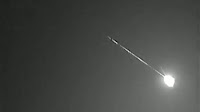The Lyrid Meteors will be visible between Saturday 16 and Monday 25 April 2006, with peak acticity on Friday 22 April, when the number of meteors may exceed 20 per hour. However with the Full Moon also falling on 22 April, potentially impeding viewing, so the best time to view the shower may be at the begining and end of its visibilty.
The radiant point of the Lyrid Meteors. Heavens Above.
The Lyrid Meteors are comprised of debris from the comet C/1861 G1
Thatcher (named after the astronomer A. E. Thatcher, not the
politician). This is a long-period comet that spends most of its time in
the Oort Cloud, only visiting the inner Solar System once every 415
years, the last occasion being in 1861. When the comet visits the inner
Solar System it is heated by the Sun, melting the ices that make up its
surface and releasing a trail of dust, which continues to follow the
path of the comet. The Earth passes through this trail in April each
year, creating a light show as the dust particles burn in the upper
atmosphere which appears to radiate from the star Vega in the constellation of Lyra.
The orbit and current position of C/1861 G1 Thatcher. Image created using the JPLSmall-Body Database Browser.
See also...
 Bright 'fireball' meteor seen over much of New Zealand. Witnesses have reported seeing a bright fireball type meteor over much
of New Zealand at about 9.00 pm local time on Tuesday 5 April 2016. The
meteor has...
Bright 'fireball' meteor seen over much of New Zealand. Witnesses have reported seeing a bright fireball type meteor over much
of New Zealand at about 9.00 pm local time on Tuesday 5 April 2016. The
meteor has... Bright 'fireball' meteor seen over much of England. The UK Meteor Observation Network
has recieved roports of a bright fireball meteor being seen over much
of southern England slightly after 3.15 am GMT...
Bright 'fireball' meteor seen over much of England. The UK Meteor Observation Network
has recieved roports of a bright fireball meteor being seen over much
of southern England slightly after 3.15 am GMT... Fireball seen over southern France and northern Italy. A bright fireball was seen over much of southeast France and northern
Italy at about 6.20 pm local time on Wednesday 17...
Fireball seen over southern France and northern Italy. A bright fireball was seen over much of southeast France and northern
Italy at about 6.20 pm local time on Wednesday 17...
Follow Sciency Thoughts on Facebook.


